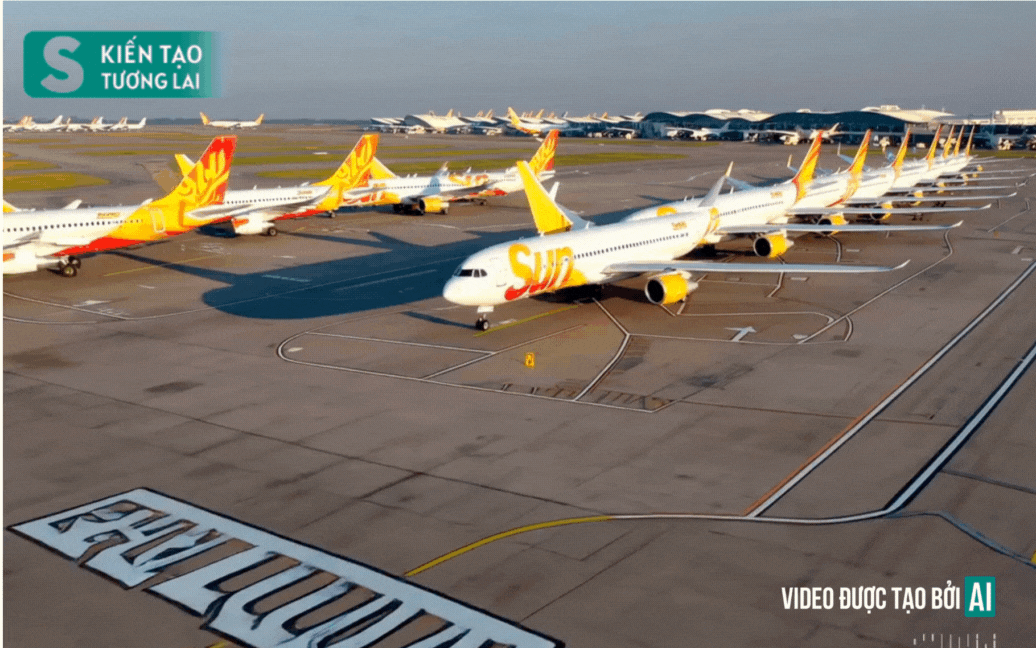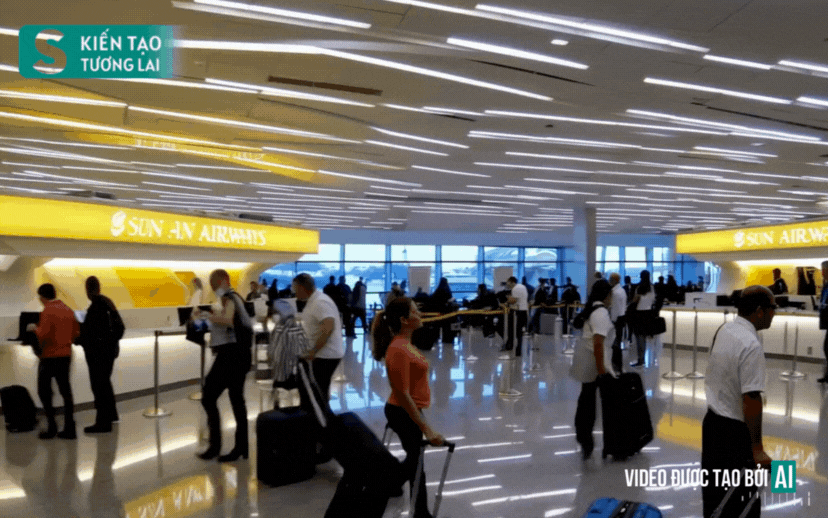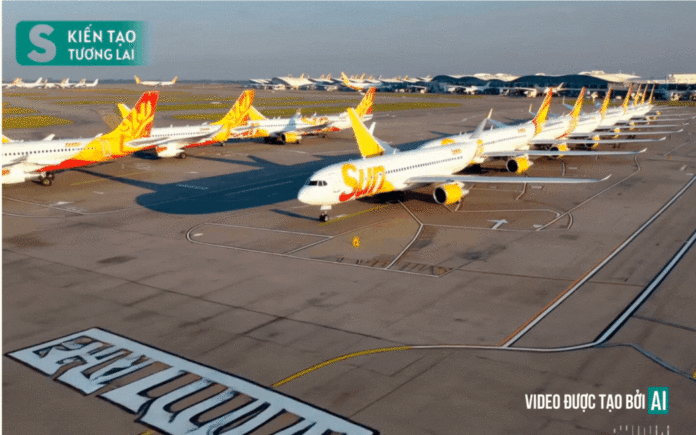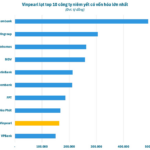Take a look at this AI-generated glimpse into the future: Vietnam’s newest airline operating at Phu Quoc Airport, following its anticipated upgrade.
Can Vietnam’s Tourism Industry Now Soar to New Heights?
Over the years, the rapid growth of Vietnam’s marine tourism industry, particularly in renowned destinations such as Phu Quoc, Nha Trang, and Da Nang, has underscored the urgent need to enhance air connectivity to accommodate the surge in visitors, especially the influx of international tourists.
The recently approved Sun Phu Quoc Airways (SPA) project, backed by Sun Group with a total investment of VND 2,500 billion (nearly USD 99 million), is expected to boast a fleet of 31 aircraft by 2030. The airline’s mission is to bring international travelers to the pearl island of Phu Quoc, while also making it more accessible for Vietnamese nationals to explore this breathtaking destination.
The official approval of this airline by the Prime Minister marks a significant milestone for Vietnam’s aviation industry and the development of Phu Quoc’s tourism sector.

AI-generated illustration of SPA’s future 31-aircraft fleet
Choosing Phu Quoc as its primary hub not only capitalizes on the island’s booming tourism but also aligns with the strategy to develop transportation infrastructure, international airports, and upscale resort projects.
Phu Quoc is increasingly regarded as the shining gem of Vietnam’s tourism industry, renowned worldwide for its pristine beaches and stunning islands. Having a dedicated airline based here will strengthen connectivity, making Phu Quoc more accessible to both domestic and international travelers.
Operating more direct flights to and from Phu Quoc will significantly improve access to this island paradise for key domestic and international markets. This will not only boost international tourist arrivals but also encourage more domestic travelers to visit Phu Quoc.
Consequently, accommodation, dining, entertainment, and shopping services in Phu Quoc will flourish, positively impacting the local economy and enhancing the livelihoods of its residents.
Additionally, establishing flight connections between Phu Quoc and thriving economic, financial, and commercial hubs will stimulate trade, foster business connections, and expand markets, creating numerous cooperation and investment opportunities for Southern Vietnam and the country as a whole.
Diversifying Vietnam’s Aviation Landscape
Currently, Vietnam boasts a well-developed network of domestic and international airlines, with five prominent domestic carriers operating nearly 50 domestic routes connecting key economic and cultural centers such as Hanoi, Ho Chi Minh City, Da Nang, Nha Trang, and Hai Phong. Vietnamese airlines have also expanded their reach internationally, catering to the growing travel and business demands of locals and enterprises.
The introduction of a new airline in the Vietnamese market offers passengers more choices for domestic and international travel. This diversification fosters healthy competition, prompting existing airlines to enhance their service quality, adjust pricing strategies, and innovate to better meet market demands.
Notably, the new airline is expected to blend traditional commercial passenger transportation with charter flight operations.
By incorporating charter flights, the airline can focus on serving high-end tourists, business travelers, and large groups requiring flexible schedules, especially those traveling to coastal destinations and prominent economic hubs. This approach also helps alleviate the strain on traditional commercial routes that are becoming increasingly congested.
Moreover, the planned expansion of the fleet to 31 aircraft within five years underscores the airline’s potential contribution to Vietnam’s overall air cargo and passenger capacity, supporting the growth of both domestic and international cargo and passenger traffic.

AI-generated illustration of SPA’s future check-in area
The government’s decision to approve the establishment of this new airline will generate numerous direct and indirect job opportunities in the aviation, airport services, transportation, tourism, and related sectors. This will contribute to Vietnam’s economic growth, generate substantial tax and service revenue, and enhance the country’s standing in the regional and global aviation landscape.
As Vietnam embarks on a new era of international integration and sustainable development, the presence of a new airline will not only intensify competition within the industry but also foster a dynamic, modern, and diverse economy, propelling the nation closer to its aspiration of becoming a regional and global hub for transportation, tourism, and trade.
Regarding Phu Quoc Airport, the Vietnam Aviation Authority, in collaboration with the People’s Committee of Kien Giang province, recently unveiled the master plan for Phu Quoc International Airport for the period 2021-2030, with a vision towards 2050. The airport’s design was penned by Steven Thor, Executive Vice President of CPG Consultants, a leading Singapore-based architecture firm.
According to the design team, the Phu Quoc International Airport will undergo a comprehensive upgrade to become one of the world’s most modern and intelligent airports, playing a pivotal role in Vietnam’s transportation and tourism infrastructure development, especially in preparation for the APEC 2027 summit.
The airport’s passenger terminal will be a standout feature, designed with the graceful wingspan of a phoenix, symbolizing national pride and prestige. It will also be equipped with state-of-the-art operational technology, including off-site check-in options, automated baggage handling, and biometric identification, reducing immigration processing time to just 15-30 seconds per person.
Notably, the airport will feature two runways, including an extension of the existing runway to 3,500 meters and the construction of a new 3,300-meter runway. The apron system will be expanded to accommodate over 100 aircraft parking positions, including 45 spots for wide-body aircraft, complete with modern jet bridges to facilitate seamless international and domestic passenger handling.
A New Airline Takes Flight: Vietnam’s Seventh Carrier Presents a Golden Opportunity with a Whopping $2.5 Billion Investment
Introducing the seventh airline to join the skies over Vietnam, offering a unique and exceptional flying experience. With an already established aviation industry, this new airline is set to take off and soar above the rest.
The New Airport Revolution: Unveiling the Nation’s Upcoming Aviation Hubs
Recently, a string of major airports across the country have been given the green light for investment and construction, with many projects already taking shape.
The Green Trail: A Collaborative Effort by Three North Central Provinces to Create an Eco-Friendly Inter-Regional Tourism Experience
The collaboration between the three north-central provinces of Ninh Binh, Thanh Hoa, and Nghe An to develop sustainable green tourism trails is a groundbreaking initiative. By working together, these provinces are not only conserving their natural resources but also revolutionizing regional branding, enhancing visitor experiences, and attracting tourists from far and wide.





















